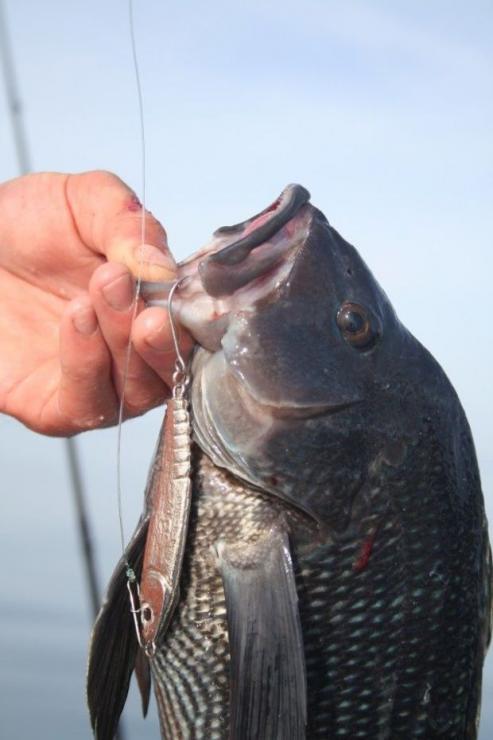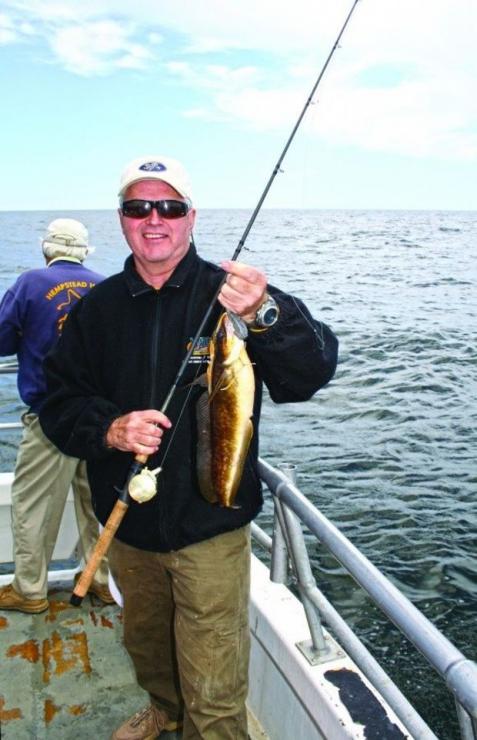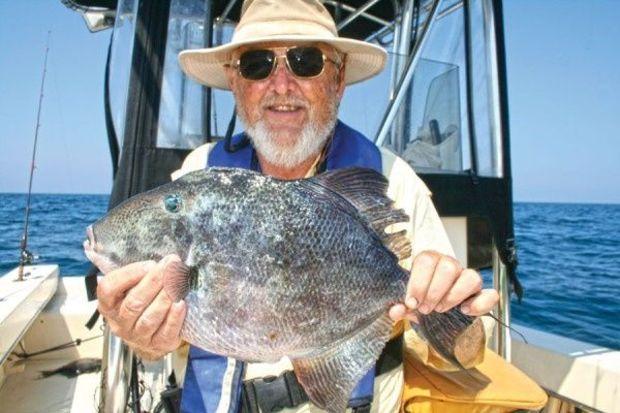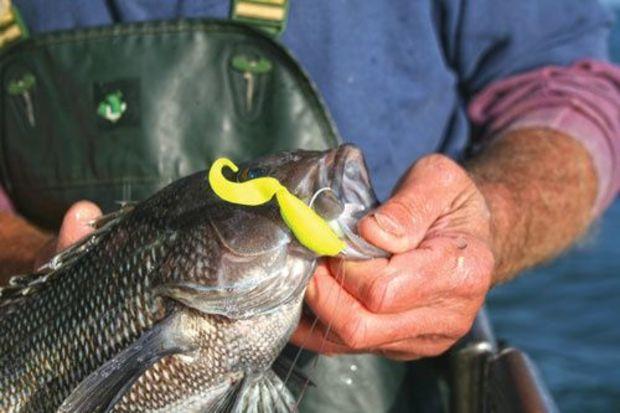When it comes to fast and exciting action, nothing beats catching one fish after another over a reef or wreck. It may be sea bass in the ocean, rockfish in the bays, or any one of a dozen other species that hug their manmade home on the bottom.
The numerous reefs and wrecks in the bays and the ocean hold lots of fish, but it takes a bit of knowhow to catch them successfully. The primary reason why fish hang out in these locations is food, whether it be the invertebrates at the bottom of the chain or the blues, sea bass, and rockfish at the top. The primary food source is attached to the structure so the target fish seldom stray far afield.
Location, Location, Location!
As in real estate, location is the key to successful structure fishing. You must be in the correct location, not six feet or even six inches away. To accomplish this it will be necessary for you to know the GPS or LORAN coordinates of the reef or wreck. Today’s anglers are fortunate because there are charts and books that provide these coordinates. Unfortunately, not all GPS machines are identical, so it is necessary to use a little detective work to find the exact location. First, run to the coordinates on the chart and if the structure shows up on your SONAR, good for you. If the SONAR shows empty bottom, drop a marker buoy over the side and commence a search in a circular pattern around the buoy. Sooner or later you will mark the wreck or reef where you should drop another buoy. At this point, record the coordinates and these will always take you back to that location. I mentioned LORAN and know it is no longer available, but many old timers still use these coordinates by converting the GPS to LORAN. You may hear someone on the radio talking in LORAN, and you don’t understand where they are. That’s the point.\
Now that you have found your fishing hole, the next decision is whether to anchor or drift. Most of the time, when conditions are conducive to drifting (light winds and current in reasonably shallow water), that will be my preferred technique. When the water is much over 50 feet, or the wind and current carry the boat too fast to fish, I will set the anchor. Using the buoy you dropped on the structure, drift away while keeping an eye on the compass. Once you are 100 yards or so from the buoy, run back on the reciprocal heading and go past the buoy far enough to set the anchor and have it come tight before the boat reaches the wreck or reef.
When deciding how far to run past the buoy, consider the water depth and the amount of rode needed to hold the anchor on the bottom. Never, ever anchor from the stern! In some cases you may want to use a wreck anchor or grapple. This type of anchor will set the boat directly on the structure, but can be dangerous because of the short rode used. Never use a wreck anchor in big seas because there is not enough rode between the bow and the water to keep a large wave from coming aboard. Once the first one comes over the bow, sinking is imminent. I have seen this happen, and the boat will go down in a matter of seconds.
Bottom Fishing
Many of the fish on a wreck or reef live on the bottom. Sea bass, tog, croaker, flounder, and ling will be tight to the structure, and you must set the bait directly on their dinner plate. I find a top-bottom rig using the least amount of material to be the best for this fishery. When tog are the target species, I only use one hook because these fish live in the structure and the loss of rigs is a part of the process.
Using a two- to three-foot length of 50-pound mono, tie a surgeon’s loop in one end for the sinker and a perfection loop in the other and attach it to the running line. Between these two, tie two more surgeon’s loops. Attach circle hooks to the last two loops by pushing the end of the loop through the eye of the hook, then push the hook back through the loop.
I only use circle hooks when fishing with bait. The exception is when fishing for tog because these fish never get the hook inside their mouth, so a circle hook does not work any better than a J hook. I like a Virginia-style hook for tog. In recent years, the addition of a green Gulp! three- or four–inch swimming mullet to the hook along with whatever bait you are using has improved the catch. I was skeptical until outfished by a 16-year-old-girl on a New Jersey head boat. Now, every bit of bait that I send to the bottom has a Gulp! companion.
I use only 60-pound braided line with a six- or seven-foot, 50-pound mono shock leader attached with an Albright knot on a conventional reel and a rod capable of holding at least eight ounces of lead when bottom fishing. Spinning reels do not allow enough control of the line when dropping down and do not have the power to pull a big tog out of the rubble.
When working rubble for flounder, use a different technique. These fish will often stage on top of such structure as railroad cars, and you must present the bait directly to them. I find the best method for accomplishing this is to use a bucktail with a strip of natural bait or Gulp!. The bucktail must be heavy enough to stay on the bottom, and using models with sparse hair will help in the endeavor. Jigging the bucktail from an anchored boat is done by dropping the lure straight down and then raising and lowering the rod tip while letting out line as the bucktail moves away in the current. When drifting, you must be constantly aware of the bottom structure and be able to lift the lure over and then let it fall alongside upwellings.
Mid-Water Fishing
Triggerfish and spadefish have become targets over wrecks and reefs since the 1990s when they first appeared in local waters. My initial encounter with them was in Virginia, and now they have moved up into the Delaware Bay. The best way to catch them is by anchoring the boat 20 feet or so off the structure rather than right on top. Use small, cut-up clam pieces for bait and chum with the same. Very small circle hooks must be employed as both of these fish have small mouths. Tie the hook directly to the end of your line or use 10- to 15-pound fluorocarbon leader. Most of the time no weight is required, but under strong current or windy conditions, a small rubber-core sinker may be needed. Place it a few feet above the hook.
Spadefish can drive you nuts. They often stage in great schools refusing to eat anything you toss their way. When you encounter this situation, pack up and move on. In my experience, they are not going to turn on anytime soon. If you keep moving around to different locations, sooner or later you will find some that are hungry. Once you do get a school of spades and triggers willing to eat, the action will be fast and furious. If you are unexperienced in the ways of these fish, it is best to put your rod in a holder and not pick it up until it bends double. Both species have a tendency to nibble at the bait, and most anglers can’t resist the urge to strike at the first bite. Using a circle hook, the fish will impale itself, and then the fight is on.
Trolling
Several species may be found feeding over a wreck or reef. These include bluefish, Spanish mackerel, king mackerel, and rockfish. Trolling is the best way to locate them, and then set up a chum slick if the situation is suitable for this technique. It is not unusual to see mackerel or bluefish jumping out of the water as they chase bait over a wreck or reef. When this activity is occurring, set up your trolling spread well before arriving at the scene of the action. I like to pull spoons over a wreck, with Drones or Tonys at the top of my list.
For Spanish I use the smallest models rigged on 15-pound mono line. The leader should be at least 30 feet long for maximum action from the lure. The size of the bluefish or the bait will determine the size of the spoon. Medium-sized blues will often be feeding on very small bait so small spoons will be in order. Larger bait or larger blues will require a larger spoon and a heavier leader. The length of the leader remains at 30 feet no matter the size of the spoon. To run a spoon close to the surface, place a trolling sinker between the leader and the running line. I always use a ball bearing swivel to connect line and leader placing the sinker between the leader and the swivel. To put the spoon down deeper, nothing beats a planer. I use a #1 Drone planer for Spanish, moving up as the size of the spoon increases. Downriggers will work, but dragging that weight over a wreck or reef invites disaster.
Jigging
Jigging can be very effective when fishing over a wreck or reef. I have been using AVA and Diamond jigs for many years, and now we have those fancy $20 models from Williamson and Shimano. I must admit a bit of reluctance to sending a $20 bill to the bottom, where it may or may not decide to stay, but my son Ric has had excellent success with these jigs over deep water wrecks.
Jigging can be done from an anchored or drifting boat and will catch a wide variety of fish including sea bass, flounder, blues, mackerel, and even the occasional tog. The idea is to drop down until you feel the bottom and then raise the jig up so it flutters just above the structure. Keep jigging, and if no hits occur, drop down a bit more until the bottom is contacted again. It may take a few drops and perhaps a jig or two before discovering the action the fish like. If you like to catch fish, you really should perfect your wreck and reef fishing techniques. It does take a bit of time and labor to become proficient, but the results are well worth the effort.



